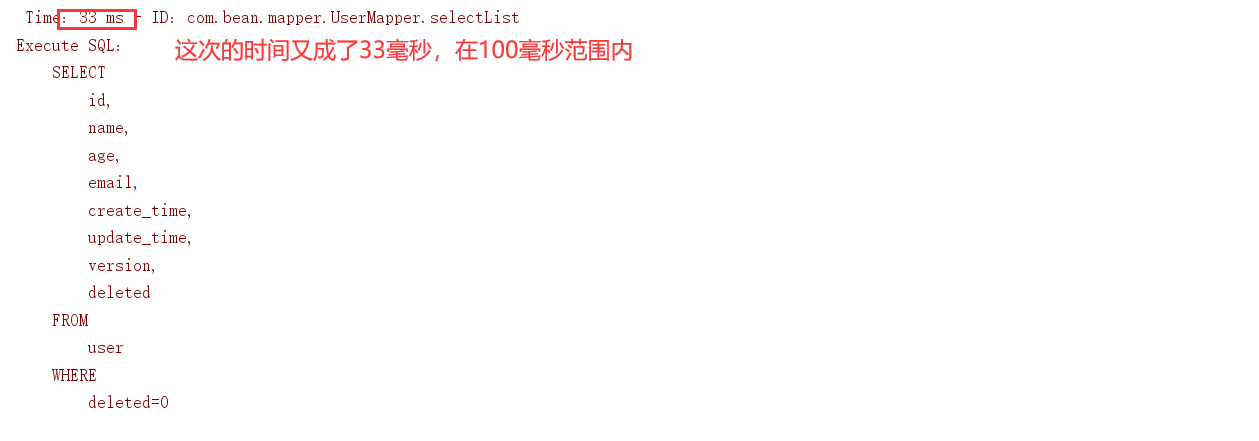 MybatisPlus
MybatisPlus
# MybatisPlus
- 官网
https://mp.baomidou.com/:MybatisPlus官网
这个官网,baomidou,苞米豆
特性:
- 无侵入:只做增强不做改变,引入它不会对现有工程产生影响,如丝般顺滑
- 损耗小:启动即会自动注入基本 CURD,性能基本无损耗,直接面向对象操作
- 强大的 CRUD 操作:内置通用 Mapper、通用 Service,仅仅通过少量配置即可实现单表大部分 CRUD 操作,更有强大的条件构造器,满足各类使用需求
- 支持 Lambda 形式调用:通过 Lambda 表达式,方便的编写各类查询条件,无需再担心字段写错
- 支持主键自动生成:支持多达 4 种主键策略(内含分布式唯一 ID 生成器 - Sequence),可自由配置,完美解决主键问题
- 支持 ActiveRecord 模式:支持 ActiveRecord 形式调用,实体类只需继承 Model 类即可进行强大的 CRUD 操作
- 支持自定义全局通用操作:支持全局通用方法注入( Write once, use anywhere )
- 内置代码生成器:采用代码或者 Maven 插件可快速生成 Mapper 、 Model 、 Service 、 Controller 层代码,支持模板引擎,更有超多自定义配置等您来使用
- 内置分页插件:基于 MyBatis 物理分页,开发者无需关心具体操作,配置好插件之后,写分页等同于普通 List 查询
- 分页插件支持多种数据库:支持 MySQL、MariaDB、Oracle、DB2、H2、HSQL、SQLite、Postgre、SQLServer 等多种数据库
- 内置性能分析插件:可输出 Sql 语句以及其执行时间,建议开发测试时启用该功能,能快速揪出慢查询
- 内置全局拦截插件:提供全表 delete 、 update 操作智能分析阻断,也可自定义拦截规则,预防误操作
# 快速入门
- Maven
<!-- 数据库驱动 -->
<dependency><groupId>mysql</groupId>
<artifactId>mysql-connector-java</artifactId>
</dependency>
<!-- lombok -->
<dependency>
<groupId>org.projectlombok</groupId>
<artifactId>lombok</artifactId>
</dependency>
<!-- mybatis-plus -->
<!-- mybatis-plus 是自己开发,并非官方的! -->
<dependency>
<groupId>com.baomidou</groupId>
<artifactId>mybatis-plus-boot-starter</artifactId>
<version>3.0.5</version>
</dependency>
- 数据库
DROP TABLE IF EXISTS user;
CREATE TABLE user
(
id BIGINT(20) NOT NULL COMMENT '主键ID',
name VARCHAR(30) NULL DEFAULT NULL COMMENT '姓名',
age INT(11) NULL DEFAULT NULL COMMENT '年龄',
email VARCHAR(50) NULL DEFAULT NULL COMMENT '邮箱',
PRIMARY KEY (id)
);
DELETE FROM user;
INSERT INTO user (id, name, age, email) VALUES
(1, 'Jone', 18, 'test1@baomidou.com'),
(2, 'Jack', 20, 'test2@baomidou.com'),
(3, 'Tom', 28, 'test3@baomidou.com'),
(4, 'Sandy', 21, 'test4@baomidou.com'),
(5, 'Billie', 24, 'test5@baomidou.com');
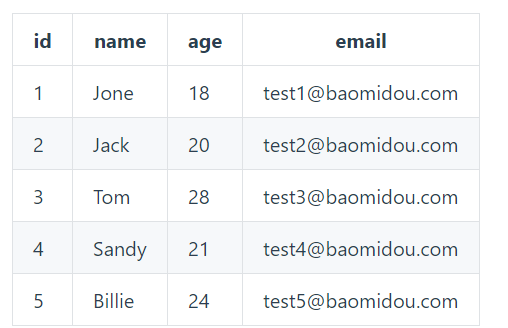
注意:
- 不要同时导入Mybatis和Mybatis-plus,因为有一些依赖的区别
- 配置
## Mysql5:com.mysql.jdbc.Driver,Mysql8:com.mysql.cj.jdbc.Driver,并且需要增加时区配置
## 8版本兼容低版本,所以也可以使用com.mysql.cj.jdbc.Driver
spring.datasource.username=root
spring.datasource.password=root
spring.datasource.url=jdbc:mysql://localhost:3306/mybatis_plus?useSSL=false&useUnicode=true&characterEncoding=utf-8&serverTimezone=Asia/Shanghai
spring.datasource.driver-class-name=com.mysql.jdbc.Driver
POJO-DAO传统方式:很复杂POJO-DAO使用了MybatisPlus之后- POJO
package com.bean.pojo;
import lombok.AllArgsConstructor;
import lombok.Data;
import lombok.NoArgsConstructor;
@Data
@AllArgsConstructor
@NoArgsConstructor
public class User {
private Long id;
private String name;
private Integer age;
private String email;
}
2. Mapper接口
package com.bean.mapper;
import com.baomidou.mybatisplus.core.mapper.BaseMapper;
import com.bean.pojo.User;
import org.apache.ibatis.annotations.Mapper;
import org.springframework.stereotype.Repository;
//在对应的mapper上实现基本的接口BaseMapper
@Repository
public interface UserMapper extends BaseMapper<User> {
}
配完了,因为继承了父类,所以所有的方法都基于父类,但是也可以自己编写服务
3. 扫描包
package com.bean;
import org.mybatis.spring.annotation.MapperScan;
import org.springframework.boot.SpringApplication;
import org.springframework.boot.autoconfigure.SpringBootApplication;
@MapperScan("com.bean.mapper")
@SpringBootApplication
public class MybatisPlusApplication {
public static void main(String[] args) {
SpringApplication.run(MybatisPlusApplication.class, args);
}
}
4. 使用
package com.bean;
import com.bean.mapper.UserMapper;
import com.bean.pojo.User;
import org.junit.jupiter.api.Test;
import org.springframework.beans.factory.annotation.Autowired;
import org.springframework.boot.test.context.SpringBootTest;
import java.util.List;
@SpringBootTest
class MybatisPlusApplicationTests {
@Autowired
private UserMapper userMapper;
@Test
void contextLoads() {
//查询所有用户,参数是一个条件构造器,不用就写null
List<User> users = userMapper.selectList(null);
for (User user : users) {
System.out.println(user);
}
}
}
User(id=1, name=Jone, age=18, email=test1@baomidou.com)
User(id=2, name=Jack, age=20, email=test2@baomidou.com)
User(id=3, name=Tom, age=28, email=test3@baomidou.com)
User(id=4, name=Sandy, age=21, email=test4@baomidou.com)
User(id=5, name=Billie, age=24, email=test5@baomidou.com)
# 配置日志输出
所有的SQL都是不可见的,我们要知道这个是怎么执行的,所以要配置日志
## 配置日志
mybatis-plus.configuration.log-impl=org.apache.ibatis.logging.stdout.StdOutImpl
Log4j和Sel4j都需要导包,这里就是用默认的可以了
配置完成之后,后面的学习就需要注意这个自动生成的SQL
JDBC Connection [HikariProxyConnection@157201184 wrapping com.mysql.cj.jdbc.ConnectionImpl@2f521c4] will not be managed by Spring
==> Preparing: SELECT id,name,age,email FROM user
==> Parameters:
<== Columns: id, name, age, email
<== Row: 1, Jone, 18, test1@baomidou.com
<== Row: 2, Jack, 20, test2@baomidou.com
<== Row: 3, Tom, 28, test3@baomidou.com
<== Row: 4, Sandy, 21, test4@baomidou.com
<== Row: 5, Billie, 24, test5@baomidou.com
<== Total: 5
Closing non transactional SqlSession [org.apache.ibatis.session.defaults.DefaultSqlSession@71e35c4]
User(id=1, name=Jone, age=18, email=test1@baomidou.com)
User(id=2, name=Jack, age=20, email=test2@baomidou.com)
User(id=3, name=Tom, age=28, email=test3@baomidou.com)
User(id=4, name=Sandy, age=21, email=test4@baomidou.com)
User(id=5, name=Billie, age=24, email=test5@baomidou.com)
# 插入测试和雪花算法
# CRUD扩展
# 插入
@Test
void testInsert() {
User user = new User().setName("BEAN").setAge(20).setEmail("xxx@qq.com");
System.out.println(user);
int insert = userMapper.insert(user);
System.out.println(insert);
}
User(id=null, name=BEAN, age=20, email=xxx@qq.com)
Creating a new SqlSession
SqlSession [org.apache.ibatis.session.defaults.DefaultSqlSession@6fc6deb7] was not registered for synchronization because synchronization is not active
JDBC Connection [HikariProxyConnection@232200992 wrapping com.mysql.cj.jdbc.ConnectionImpl@767f6ee7] will not be managed by Spring
==> Preparing: INSERT INTO user ( id, name, age, email ) VALUES ( ?, ?, ?, ? )
==> Parameters: 1240941797300097026(Long), BEAN(String), 20(Integer), xxx@qq.com(String)
<== Updates: 1
虽然ID没有写,但是我们发现自动生成了id
数据库插入的id的默认值为唯一id
# 主键生成策略
主键生成策略
主键自增
- 在实体类上的主键加上注解
@TableId(type = IdType.AUTO)
@Data
@AllArgsConstructor
@NoArgsConstructor
@Accessors(chain = true)
public class User {
@TableId(type = IdType.AUTO)
private Long id;
private String name;
private Integer age;
private String email;
}
- 数据库的主键字段一定要是自增的
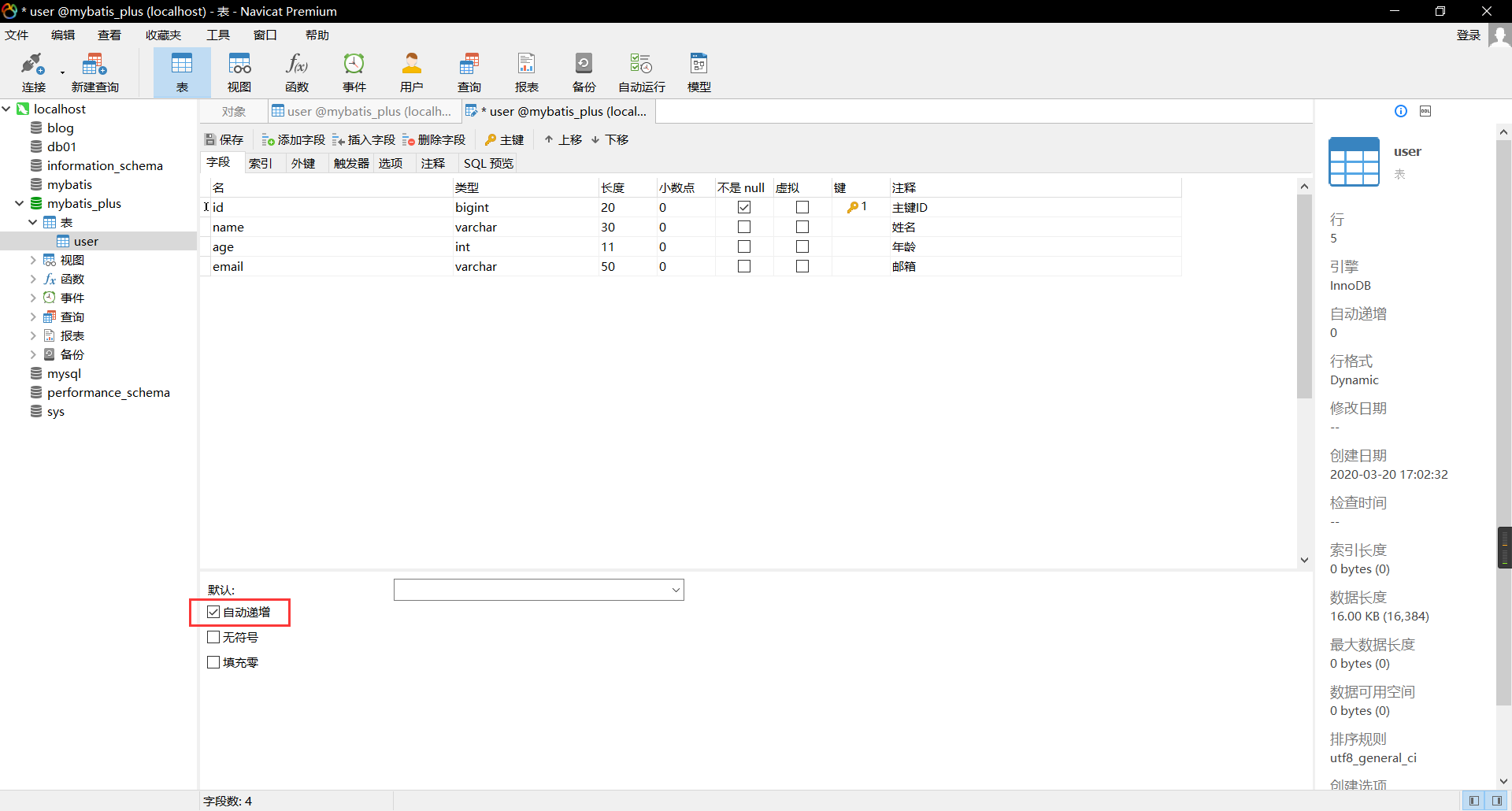
测试:
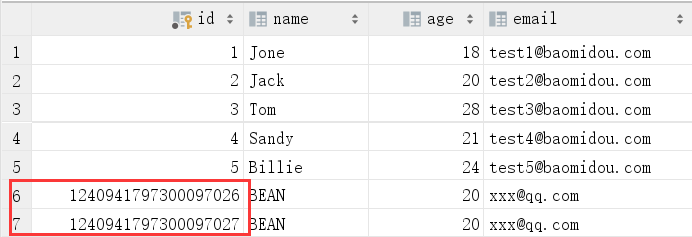
除了上面的自增长策略之外,还有这些策略
AUTO(0), //自增
NONE(1), //不操作
INPUT(2), //手动输入
ID_WORKER(3), //全局唯一,默认方案,适用情况是主键是数字类型的时候
UUID(4), //UUID
ID_WORKER_STR(5); //默认方案的字符串表示方案,也就是雪花算法的字符串表示形式,适用情况是当主键是字符串类型的时候
比较多的:uuid,自增id,雪花算法,redis,zookeeper
雪花算法
雪花算法是推特开源的分布式ID生成算法,结果是一个Long类型的ID。其核心思想是:
使用41bit作为毫秒数
- 10bit作为机器的ID(5bit为数据中心【不同的数据中心,比如北京,上海,等等】,5bit为机器ID)
- 12bit作为毫秒内的流水号
- 最后一个符号位为0
雪花算法是MP中的默认策略
UUID
比如:3F2504E0-4F89-11D3-9A0C-0305E82C3301
UUID,每次生成的唯一的值。也有缺点,缺点是排序不方便。
Redis
有人使用Redis来进行主键的策略生成,主要的实现方式就是利用redis的原子性操作。
比如现在有5台Redis服务器:A,B,C,D,E
这5台服务器的初始值为:A-1,B-2,C-3,D-4,E-5。这几台Redis的步长都是5。
那么就会出现:
A:1,6,11,16
B:2,7,12,17
C:3,8,13,18
D:4,9,14,19
E:5,10,15,20
这样做的好处是:不依赖于数据库并且优于数据库,数字排序方便
坏处是:如果系统中没有Redis,引入Redis就比较麻烦
# 更新
@Test
void testUpdate() {
User user = new User().setId(1240941797300097026L).setName("howling").setAge(20).setEmail("xxx@163.com");
userMapper.updateById(user);//这里需要的是对象不是id
}

看到这里的,我们惊喜的发现mybatisPlus可以根据条件自动拼接动态SQL,所以以后我们就不需要对动态SQL费脑筋了
# 自动填充
- 创建时间
- 修改时间
一般这个操作就是自动化完成的,我们不希望手动更新
阿里巴巴的开发手册中写道:所有的数据库表几乎都要有创建时间,修改时间这两个字段,而且需要自动化
方式一:数据库级别修改(工作中不建议使用)
- 在表中新增字段:
create_time,update_time

- 把实体类同步
@Data
@AllArgsConstructor
@NoArgsConstructor
@Accessors(chain = true)
public class User {
@TableId(type = IdType.AUTO)
private Long id;
private String name;
private Integer age;
private String email;
private Data createTime;
private Data updateTime;
}
- 插入
@Test
void testInsert() {
User user = new User().setName("BEAN").setAge(20).setEmail("xxx@qq.com");
System.out.println(user);
int insert = userMapper.insert(user);
System.out.println(insert);
}
- 查看

方式二:代码级别(工作中建议使用)
- 删除数据库的默认值

- 实体类的字段属性上需要增加注解
- 字段属性
- 填充策略
@TableField
public enum FieldFill {
DEFAULT, //默认,不操作
INSERT, //插入时操作
UPDATE, //更新时操作
INSERT_UPDATE; //插入和更新时操作
private FieldFill() {
}
}
@Data
@AllArgsConstructor
@NoArgsConstructor
@Accessors(chain = true)
public class User {
@TableId(type = IdType.AUTO)
private Long id;
private String name;
private Integer age;
private String email;
@TableField(fill = FieldFill.INSERT)
private Date createTime;
@TableField(fill = FieldFill.INSERT_UPDATE)
private Date updateTime;
}
- 编写处理器处理这个注解
@Component //把处理器加入到IOC中
@Slf4j //日志,可以看清楚具体做了什么
public class MyDataObjectHandler implements MetaObjectHandler {
//插入时的填充策略
@Override
public void insertFill(MetaObject metaObject) {
log.info("start insert fill....");
//String fieldName:字段名, Object fieldVal 插入的字段值, MetaObject metaObject
this.setFieldValByName("createTime",new Date(),metaObject);
this.setFieldValByName("updateTime",new Date(),metaObject);
}
//更新时的填充策略
@Override
public void updateFill(MetaObject metaObject) {
log.info("start update fill....");
this.setFieldValByName("updateTime",new Date(),metaObject);
}
}
- 实验插入和更新
- 插入
@Test
void testInsert() {
User user = new User().setName("BEAN").setAge(20).setEmail("xxx@qq.com");
System.out.println(user);
int insert = userMapper.insert(user);
System.out.println(insert);
}

- 更新
@Test
void testUpdate() {
User user = new User().setId(1240941797300097026L).setName("howling").setAge(20).setEmail("xxx@163.com");
userMapper.updateById(user);//这里需要的是user不是id
}

# 乐观锁
在面试过程中,我们经常被问到乐观锁
其实这个非常简单
乐观锁
非常乐观,总是认为不会出现问题,无论干什么都不会去上锁。
如果出现了问题就再次更新值测试
悲观锁
十分悲观,认为总是会出现问题,无论干什么都会上锁再去操作。
我们主要讲解乐观锁
乐观锁实现方式:
- 取出记录时,获取当前version(版本)
- 更新时带上这个version
- 执行更新时,
set version = new Version where version = oldVersion - 假如version不对,就更新失败
#乐观锁: 1. 先查询,获得版本号(这里版本为1)
-- A线程,在B线程之后执行,因为version为2了,所以不会执行,这样保证了安全性
update user set name = "BEAN", version = version+1
where id=2 and version=1
-- B线程,抢先完成了,这个时候version就为2了,这样会导致A失败,保证了安全性
update user set name = "BEAN" , version = version+1
where id=2 and version=1
乐观锁的实现方式
1、首先在数据库中增加一个version字段,默认值为1作为初始版本


2、实体类增加对应的字段,并增加乐观锁注解
@Data
@AllArgsConstructor
@NoArgsConstructor
@Accessors(chain = true)
public class User {
@TableId(type = IdType.AUTO)
private Long id;
private String name;
private Integer age;
private String email;
@TableField(fill = FieldFill.INSERT)
private Date createTime;
@TableField(fill = FieldFill.INSERT_UPDATE)
private Date updateTime;
@Version //这是一个乐观锁的注解
private Integer version;
}
3、注册组件
@MapperScan("com.bean.mapper") //扫描包
@EnableTransactionManagement//事物注解
@Configuration
public class MybatisPlusConfig {
//注册乐观锁注解
@Bean
public OptimisticLockerInterceptor optimisticLockerInterceptor() {
return new OptimisticLockerInterceptor();
}
}
4、测试
//测试乐观锁,成功案例
@Test
void testOptimisticLockerSuccess() {
//1. 查询用户信息
User user = userMapper.selectById(1L);
//2. 修改用户信息
user.setName("ISHOWLING").setEmail("123@123.com");
userMapper.updateById(user);
}

//测试乐观锁,失败案例
@Test
void testOptimisticLockerFail() {
//线程1
User user = userMapper.selectById(1L);
user.setName("ISHOWLING").setEmail("123@123.com");
//线程2,模拟另外的线程执行插队操作
User user2 = userMapper.selectById(1L);
user2.setName("ISHOWLINGGGGG").setEmail("123123123@123.com");
//线程2先执行
userMapper.updateById(user2);
//线程1后执行
userMapper.updateById(user);
}

我们发现线程1的没有执行,所以成功了
注意,多线程的一定要加锁
# 查询
在快速入门的时候查询就搞定了,但是还是要来几个
单个ID查询,多个ID查询,使用Map的条件查询
@Test
void testSelect() {
//查询单个ID
User user = userMapper.selectById(1);
System.out.println(user);
//测试批量查询ID
List<User> users = userMapper.selectBatchIds(Arrays.asList(1, 2, 3));
users.forEach(System.out::println);
//条件查询之一:使用Map操作
HashMap<String, Object> map = new HashMap<>();
map.put("name","BEAN");
map.put("age",20);
List<User> list = userMapper.selectByMap(map);
list.forEach(System.out::println);
}
分页查询
分页在网站使用的十分多
- 原始的:limit
- pageHelper等第三方插件
- MybatisPlus内置的插件
我们使用MybatisPlus的分页插件:官网上讲的
- 配置拦截器组件
@MapperScan("com.bean.mapper") //扫描包
@EnableTransactionManagement//事物注解
@Configuration
public class MybatisPlusConfig {
@Bean
public PaginationInterceptor paginationInterceptor() {
PaginationInterceptor paginationInterceptor = new PaginationInterceptor();
// 设置请求的页面大于最大页后操作, true调回到首页,false 继续请求 默认false
// paginationInterceptor.setOverflow(false);
// 设置最大单页限制数量,默认 500 条,-1 不受限制
// paginationInterceptor.setLimit(500);
// 开启 count 的 join 优化,只针对部分 left join
paginationInterceptor.setCountSqlParser(new JsqlParserCountOptimize(true));
return paginationInterceptor;
}
}
但是我们不需要这么多功能,只需要:
@Bean
public PaginationInterceptor paginationInterceptor() {
return new PaginationInterceptor();
}
- 使用Page对象
import com.baomidou.mybatisplus.extension.plugins.pagination.Page;
@Test
void testPage() {
//参数一:当前页,参数二:页面中的数据,这里就是显示第一页的5条数据
Page<User> page = new Page<>(1,5);
userMapper.selectPage(page,null);
page.getRecords().forEach(System.out::println);
}
<== Columns: id, name, age, email, create_time, update_time, version
<== Row: 1, ISHOWLINGGGGG, 18, 123123123@123.com, null, 2020-03-24 10:58:29, 3
<== Row: 2, Jack, 20, test2@baomidou.com, null, null, 1
<== Row: 3, Tom, 28, test3@baomidou.com, null, null, 1
<== Row: 4, Sandy, 21, test4@baomidou.com, null, null, 1
<== Row: 5, Billie, 24, test5@baomidou.com, null, null, 1
<== Total: 5
@Test
void testPage() {
//参数一:当前页,参数二:页面大小
Page<User> page = new Page<>(2,5);
userMapper.selectPage(page,null);
page.getRecords().forEach(System.out::println);
}
<== Columns: id, name, age, email, create_time, update_time, version
<== Row: 1240941797300097026, howling, 20, xxx@163.com, null, 2020-03-24 10:36:52, 1
<== Row: 1240941797300097027, BEAN, 20, xxx@qq.com, null, null, 1
<== Row: 1240941797300097028, BEAN, 20, xxx@qq.com, 2020-03-24 10:13:47, 2020-03-24 10:13:47, 1
<== Row: 1240941797300097029, BEAN, 20, xxx@qq.com, 2020-03-24 10:34:58, 2020-03-24 10:34:58, 1
<== Total: 4
第二次查询没有5条了,只有4条
使用了分页插件之后,一切都简单了
# 删除
基本删除
@Test
void testDelete() {
//根据ID删除
userMapper.deleteById(1240941797300097027L);
//批量删除
userMapper.deleteBatchIds(Arrays.asList(1240941797300097028L,1240941797300097029L));
//根据Map删除
HashMap<String, Object> map = new HashMap<>();
map.put("name","howling");
userMapper.deleteByMap(map);
}
在工作中,会遇到逻辑删除
逻辑删除
我们分为两个删除
- 物理删除:在数据库中删除
- 逻辑删除:不在数据库中删除,而是通过一个变量让他失效,比如
delete=0=>delete=1类似回收站
- 在数据库中增加一个
delete字段,默认为0,不删除


- 实体类更新
@Data
@AllArgsConstructor
@NoArgsConstructor
@Accessors(chain = true)
public class User {
@TableId(type = IdType.AUTO)
private Long id;
private String name;
private Integer age;
private String email;
@TableField(fill = FieldFill.INSERT)
private Date createTime;
@TableField(fill = FieldFill.INSERT_UPDATE)
private Date updateTime;
@Version //这是一个乐观锁的注解
private Integer version;
private Integer deleted;
}
- 更新实体类,加注解
@Data
@AllArgsConstructor
@NoArgsConstructor
@Accessors(chain = true)
public class User {
@TableId(type = IdType.AUTO)
private Long id;
private String name;
private Integer age;
private String email;
@TableField(fill = FieldFill.INSERT)
private Date createTime;
@TableField(fill = FieldFill.INSERT_UPDATE)
private Date updateTime;
@Version
private Integer version;
@TableLogic //逻辑删除
private Integer deleted;
}
- 配置组件
@MapperScan("com.bean.mapper") //扫描包
@EnableTransactionManagement//事物注解
@Configuration
public class MybatisPlusConfig {
@Bean //逻辑删除
public ISqlInjector sqlInjector() {
return new LogicSqlInjector();
}
}
- 配置中配置逻辑删除
## 配置逻辑删除## 配置删除了的为1## 配置没有删除的为0
mybatis-plus.global-config.db-config.logic-delete-value=1
mybatis-plus.global-config.db-config.logic-not-delete-value=0
- 测试删除
@Test
void testDelete() {
//根据ID删除
userMapper.deleteById(1L);
}

- 测试查询
@Test
void testSelect() {
//查询单个ID
List<User> users = userMapper.selectList(null);
users.forEach(System.out::println);
}
==> Preparing: SELECT id,name,age,email,create_time,update_time,version,deleted FROM user WHERE deleted=0
==> Parameters:
<== Columns: id, name, age, email, create_time, update_time, version, deleted
<== Row: 2, Jack, 20, test2@baomidou.com, null, null, 1, 0
<== Row: 3, Tom, 28, test3@baomidou.com, null, null, 1, 0
<== Row: 4, Sandy, 21, test4@baomidou.com, null, null, 1, 0
<== Row: 5, Billie, 24, test5@baomidou.com, null, null, 1, 0
<== Row: 12409417973000, BEAN, 20, xxx@qq.com, 2020-03-24 11:40:11, 2020-03-24 11:40:11, 1, 0
<== Total: 5
我们可以看到查询语句自动变为
WHERE deleted=0
以上的CRUD及其扩展操作都必须精通
# 性能分析插件
我们在平时的开发中,会遇到一些慢SQL,我们可以用其他的插件做,但是MybatisPlus也提供了
作用:性能分析拦截器,用于输出每条 SQL 语句及其执行时间
- 导入插件
@MapperScan("com.bean.mapper") //扫描包
@EnableTransactionManagement//事物注解
@Configuration
public class MybatisPlusConfig {
/**
* SQL执行效率插件
*/
@Bean
@Profile({"dev","test"})// 设置 dev test 环境开启
public PerformanceInterceptor performanceInterceptor() {
PerformanceInterceptor performanceInterceptor = new PerformanceInterceptor();
performanceInterceptor.setMaxTime(1);//设置sql执行的最大时间,如果超过了则不执行,这里设置为1毫秒
performanceInterceptor.setFormat(true); //是否开启格式化支持
return performanceInterceptor;
}
}
- 因为设置了只有开发和测试环境才可以开启,所以我们要更改一下配置,改为开发环境或者测试环境
## 设置为开发环境
spring.profiles.active=dev
- 测试使用
首先我们的SQL不可能只是支持一毫秒,所以我们主要看的是报错
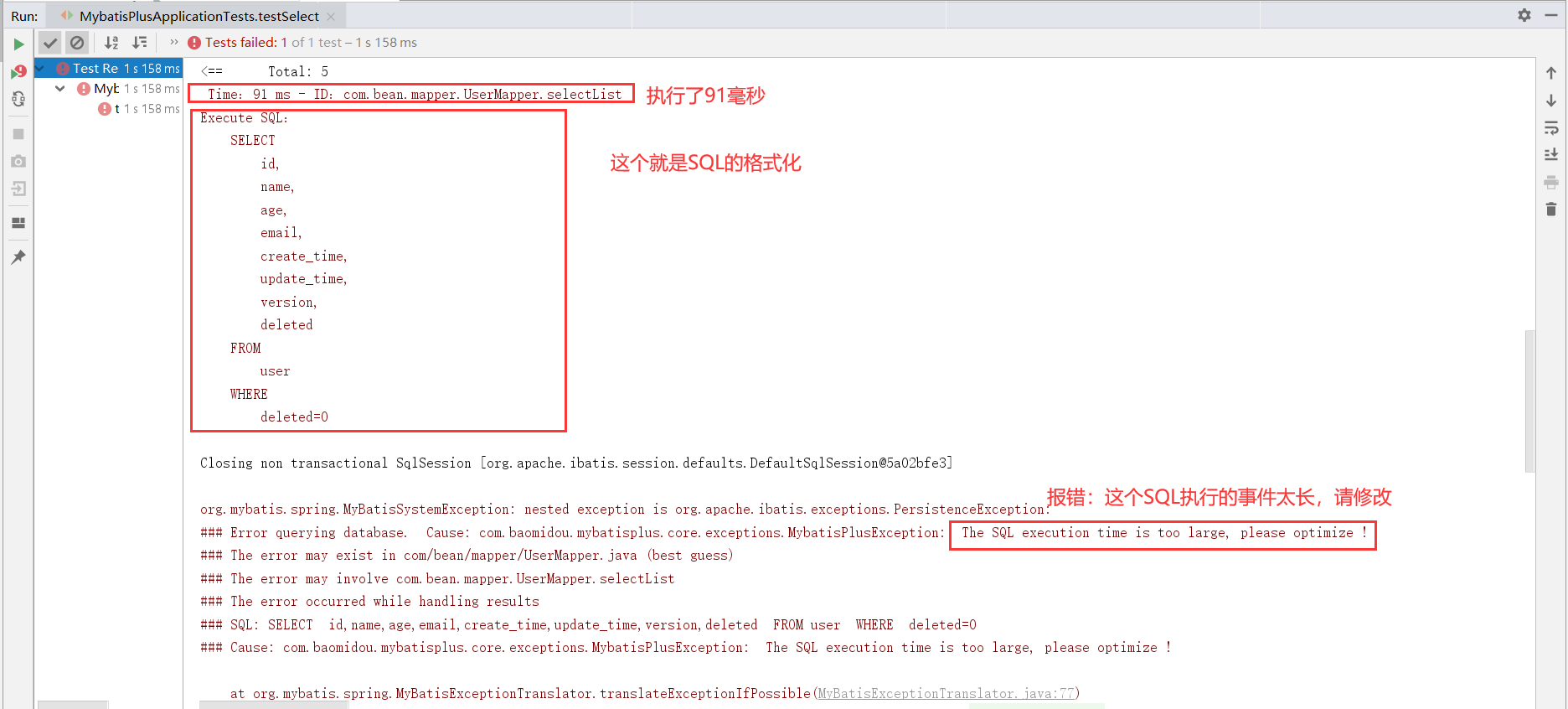
我们再改为100毫秒
performanceInterceptor.setMaxTime(100);
//设置sql执行的最大时间,如果超过了则不执行,这里设置为100毫秒`
使用 性能分析插件可以显著提高开发效率
# 条件构造器
Wrapper更多请查看官网,这里说一些常用的
条件查询,非空和大小判断
@Test
void contextLoads() {
//name不为空,邮箱不为空,年龄大于12:
QueryWrapper<User> wrapper = new QueryWrapper<>();
wrapper.isNotNull("name")//名字不为空
.isNotNull("email")//邮箱不为空
.ge("age",12)//大于等于:greater than,equal to,大于等于12
;
userMapper.selectList(wrapper).forEach(System.out::println);
}
条件查询,相等语句查询
@Test
void test2() {
//name为BEAN:
QueryWrapper<User> wrapper = new QueryWrapper<>();
wrapper.eq("name","BEAN"); //equal:等于
//selectOne:查询一个数据
System.out.println(userMapper.selectOne(wrapper));
}
范围查询
@Test
void test3() {
//查询年龄在20~30之间的用户有多少
QueryWrapper<User> wrapper = new QueryWrapper<>();
wrapper.between("name",20,30); //between:在xx~xx之间
//selectCount:查询一个总数据
System.out.println(userMapper.selectCount(wrapper));
}
模糊查询
@Test
void test4() {
//模糊查询,名字里不包含e,包含k的
QueryWrapper<User> wrapper = new QueryWrapper<>();
wrapper.notLike("name","e").like("name","k");
userMapper.selectMaps(wrapper).forEach(System.out::println);
}
左右查询
@Test
void test5() {
//模糊查询,左查询:%xxx,右查询:xxx%
//查询邮箱以t开头的,就是t%,也就是likeRight
QueryWrapper<User> wrapper = new QueryWrapper<>();
wrapper.likeRight("email","t");
userMapper.selectMaps(wrapper).forEach(System.out::println);
}
Sql嵌套查询
@Test
void test6() {
//内查询,sql嵌套sql查询
QueryWrapper<User> wrapper = new QueryWrapper<>();
wrapper.inSql("id","select id from user where id< 3");
userMapper.selectObjs(wrapper).forEach(System.out::println);
}
排序
@Test
void test7() {
//通过id进行排序
QueryWrapper<User> wrapper = new QueryWrapper<>();
//通过id进行降序排序
wrapper.orderByDesc("id");
userMapper.selectList(wrapper).forEach(System.out::println);
}
# 代码自动生成器
dao、pojo、service、controller等不写了,让程序自动生成
AutoGenerator 是 MyBatis-Plus 的代码生成器,通过 AutoGenerator 可以快速生成 Entity、Mapper、Mapper XML、Service、Controller 等各个模块的代码,极大的提升了开发效率。
构建一个代码生成器对象(这个直接抄就行,有时间可以自己写)
import com.baomidou.mybatisplus.annotation.DbType;
import com.baomidou.mybatisplus.annotation.FieldFill;
import com.baomidou.mybatisplus.annotation.IdType;
import com.baomidou.mybatisplus.generator.AutoGenerator;
import com.baomidou.mybatisplus.generator.config.DataSourceConfig;
import com.baomidou.mybatisplus.generator.config.GlobalConfig;
import com.baomidou.mybatisplus.generator.config.PackageConfig;
import com.baomidou.mybatisplus.generator.config.StrategyConfig;
import com.baomidou.mybatisplus.generator.config.po.TableFill;
import com.baomidou.mybatisplus.generator.config.rules.DateType;
import com.baomidou.mybatisplus.generator.config.rules.NamingStrategy;
import com.sun.javaws.jnl.ResourcesDesc;
import java.util.ArrayList;
public static void main(String[] args) {
AutoGenerator autoGenerator = new AutoGenerator();
//1. 全局配置:import com.baomidou.mybatisplus.generator.config.GlobalConfig;
GlobalConfig config = new GlobalConfig();
String property = System.getProperty("user.dir");//当前项目路径
config.setOutputDir(property+"/src/main/java");//输出路径:生成的代码到当前项目路径/src/main/java下
config.setAuthor("Bean");//作者
config.setOpen(false);//是否打开资源管理器
config.setFileOverride(false);//是否覆盖原来的代码
config.setServiceName("%sService");//去掉Service的I前缀
config.setIdType(IdType.ID_WORKER);//默认的ID生成策略
config.setDateType(DateType.ONLY_DATE);//日期的类型
config.setSwagger2(true);//设置Swagger
autoGenerator.setGlobalConfig(config);//设置好全局配置
//2. 设置数据源配置
DataSourceConfig dataSource = new DataSourceConfig();
dataSource.setUrl("jdbc:mysql://localhost:3306/mybatis_plus?useSSL=false&useUnicode=true&characterEncoding=utf-8&serverTimezone=Asia/Shanghai");
dataSource.setDriverName("com.mysql.cj.jdbc.Driver");
dataSource.setUsername("root");
dataSource.setPassword("root");
dataSource.setDbType(DbType.MYSQL);//设置数据库的类型
autoGenerator.setDataSource(dataSource); //设置好数据源配置
//3. 包的配置
PackageConfig packageConfig = new PackageConfig();
packageConfig.setModuleName("blog");//模块名字
packageConfig.setParent("com.bean");//放到哪个包下,那么就是com.bean.blog
packageConfig.setEntity("pojo");//实体类的名字
packageConfig.setMapper("mapper");//映射的名字
packageConfig.setService("service");//Service名字
packageConfig.setController("controller");//Controller的名字
autoGenerator.setPackageInfo(packageConfig);//设置包的配置
//4. 策略配置
StrategyConfig strategy = new StrategyConfig();
strategy.setInclude("user");//设置要映射的表名,这里是一个可变参数,可以设置多张表
strategy.setNaming(NamingStrategy.underline_to_camel);//下划线转驼峰
strategy.setColumnNaming(NamingStrategy.underline_to_camel);//下划线转驼峰
strategy.setEntityLombokModel(true);//是否使用lombok开启注解
strategy.setLogicDeleteFieldName("deleted");//逻辑删除字段
TableFill createTime = new TableFill("create_time", FieldFill.INSERT);//自动填充,创建时间
TableFill updateTime = new TableFill("update_time", FieldFill.UPDATE);//自动填充,修改时间
ArrayList<TableFill> tableFills = new ArrayList<>();
tableFills.add(createTime);
tableFills.add(updateTime);
strategy.setTableFillList(tableFills); //添加到自动填充
strategy.setVersionFieldName("version");//乐观锁
strategy.setRestControllerStyle(true);//开启Controller的Rest的驼峰命名格式
strategy.setControllerMappingHyphenStyle(true);//开启Controller的下划线形式:localhost:8080/hello_id_2
autoGenerator.setStrategy(strategy); //策略配置
autoGenerator.execute();//执行
}
报错:
java.lang.NoClassDefFoundError: org/apache/velocity/context/Context原因是缺少依赖
<!-- https://mvnrepository.com/artifact/org.apache.velocity/velocity-engine-core -->
<dependency>
<groupId>org.apache.velocity</groupId>
<artifactId>velocity-engine-core</artifactId>
<version>2.2</version>
</dependency>
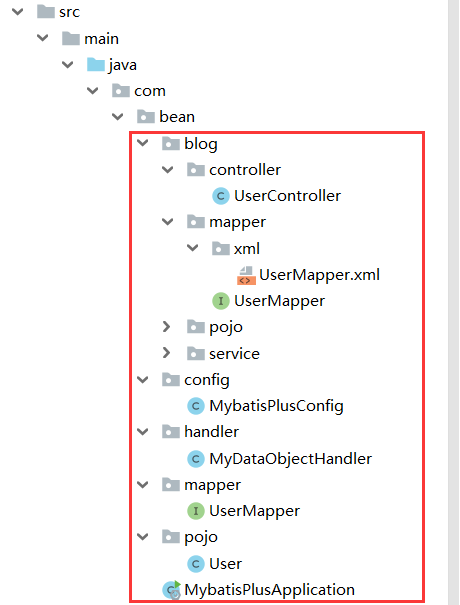
这里一切的一切都生成好了,而只需要改变一个地方:
strategy.setInclude("user");//设置要映射的表名,这里是一个可变参数,可以设置多张表


